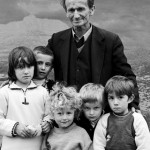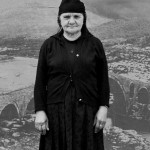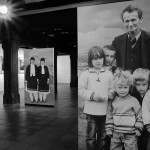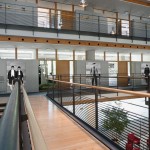Milch und Blut
Die Kirchgängerportraits: Klassisch, still, frontal posieren die Aufgenommenen, sind sich sehr bewusst, fotografiert zu werden. Für sie wohl noch etwas besonderes, aus dem Alltag herausgehobenes wie die Situation, in der die Bilder entstanden, eben das Feierliche und Festliche des Kirchgangs. Alle stehen vor demselben Hintergrund, einer stark vergrößerten Fotografie, einem Bild des berühmten albanischen Ateliers Marubi in Shkoder. Die Brücke verbindet die Bergwelt mit dem flachen Land und der Stadt. Dieser Hintergrund, wie ein gemalter Hintergrund in den Studios des 19. Jahrhunderts, löst die Fotografierten aus ihrem Zusammenhang, ihrer Umgebung. Nichts lenkt von ihnen ab, nichts „Unpassendes“ ragt ins Bild.
Die Gewänder einer katholischen Minderheit in einem mehrheitlich muslimischen Land: Die älteren Frauen tragen noch Hosen unter dem Rock und haben den Kopf bedeckt, tragen schwarz und weiß, die Männer alle im Jackett, nur die jüngeren Frauen und die Kinder sind lockerer und unterschiedlicher gekleidet. Die Gesichter sind eingelassen, auf den Moment und auf die Photographin, kaum einer schaut nicht in die Kamera.
— T.O. Immisch 2010
Milch und Blut (MILK AND BLOOD)
The churchgoers portraits: Well aware of being photographed, in Classic, quiet and frontal poses.
It seems to be something special for them, different from the daily routine just as the ceremony and festivity of going to church. All the portraits have the same background which is a greatly enlarged image by the famous Albanian ateliers Marubi in Shkodra. The bridge connects the mountains with the surrounding area and the city. Just like the painted backgrounds in the Studios of 19th century, this scenery frees the photographed persons from their environment and context. Nothing that distracts from them, nothing “inconvenient” is to be seen in the picture.
The garment of a Catholic minority in a country with a vast Muslim majority: The older ladies are still wearing trousers under their skirts, have their hair covered, and are all dressed in black and white while men wear a suit coat. Only younger women and children are more casual and freely dressed.
The faces are open to be photographed and seem to be involved with the photographer, as almost no one doesn’t look directly into the camera.
— by T.O. Immisch, 2010
























